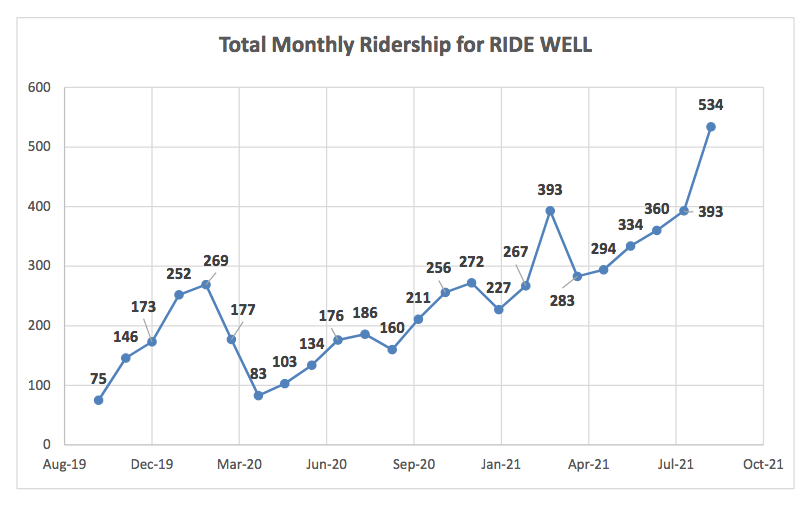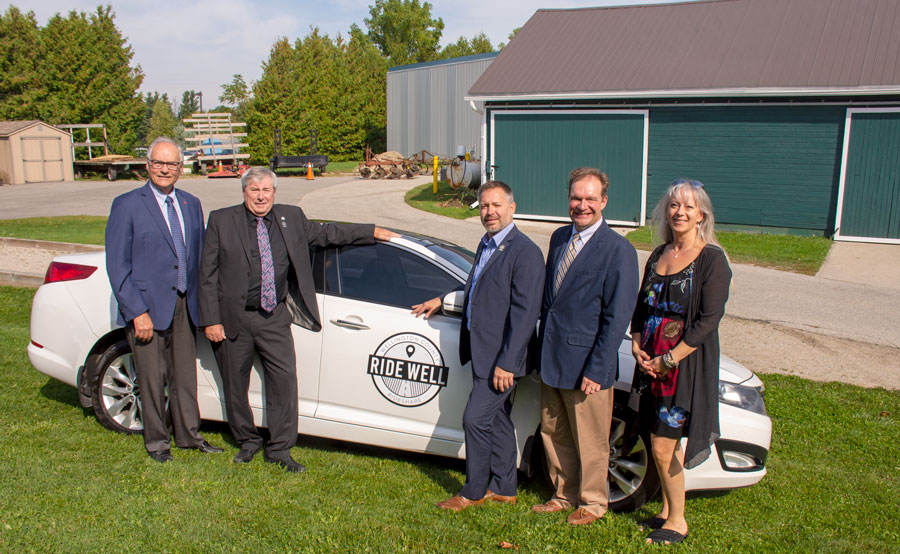WELLINGTON COUNTY – Ride Well, Wellington County’s answer to rural transit accessibility, saw record demand for the service in September before passing its second year anniversary at the beginning of October.
The transportation pilot project is funded mostly by the province’s Community Transportation Grant program, for which the province recently announced a two-year extension to carry the service through to 2025. Other funds come from the county’s economic development budget.
Offering door-to-door transportation throughout Wellington County with transfer points in Guelph, rides are booked through an app, online or by phone and fares are set at 60 cents per kilometre with a $5 minimum and $40 maximum.
The service had a slow start with lower-than-anticipated ridership during its first three months in 2019, resulting in a service reduction—measured by weekly vehicle hours.
But county data shows ridership has slowly been gaining momentum over the past two years with the most pickups and drop-offs in Centre Wellington.
The program launched in October 2019, with 394 total trips rounding out the remaining three months that year.
Comparatively, there were 345 more trips during the same period the following year, with 2,279 total trips made in 2020.
There have been 3,085 trips made this year, as of Oct. 19, an increase of roughly 35 per cent over all of 2020.
Ride distances ranged between 11 and 14km on average between June and August.
In September alone, there were 534 trips made by 73 unique passengers—the highest seen so far.

Monthly ridership totals from October 2019 to September 2021. (October Economic Development Committee report)
“Within that group 23 were new riders and 50 repeat riders,” stated an Oct. 19 report to the county’s economic development committee from economic development director Crystal Ellis.
Her report also stated there were 44 new rider accounts created.
The increase in ridership, Ellis said, is likely due to the change from virtual to in-person school, work and activities as people get back out in the community.
Increased interest in Ride Well is a welcome sign, one which Ellis believes would have been seen earlier if not for the pandemic.
Even with restrictions now lifting, gauging the success of the ride-sharing concept is all but impossible because trips are currently limited to passengers from the same pickup address, like a taxi would be.
Ride-sharing is intended to maximize the amount of seats used in a single car picking up and dropping off different people at various locations along the way.
“The less vehicle hours we’re operating and the more rides we’re doing, the more sustainable it is,” she explained.
Ellis couldn’t say what an ideal target ridership is, but said growth needs to continue.
“I would be hesitant to say if it’s sustainable yet or not, because it’s not operating as a ride-share,” Ellis said.
“I think it’s really how the service impacts your community and then where we can see it fitting properly and how to fund it because we know transportation is an issue in rural areas so we’ve just got to figure out how to make sure it works well,” she added.
Vehicle hours and the drivers behind the wheel working for RideCo—a Waterloo-based technology company which supplies the platform facilitating ride bookings—are evaluated based off the previous month’s demand and adjusted through the county’s RideCo contract.
Weekly vehicle hours were bumped from 26 hours in September to 31 hours for October to meet demand.
Ellis predicts ridership will dip back down closer to 400 monthly trips in the coming months but doesn’t foresee a significant drop like those blamed on the pandemic.
The county’s goal from here is to continue getting the word out about the service to grow ridership numbers.
“We’re trying to make sure that youth know that this is an option … now that schools are operating,” Ellis said.
As the service transitions into the intended ride-share model, Ellis said the county will be working to ensure people are comfortable with the change and understand trips will take slightly longer.
“Those are the things that I’m sort of looking at in the future, to make sure that the customer services is up to the standard we want at the county and that people are happy with the service.”




